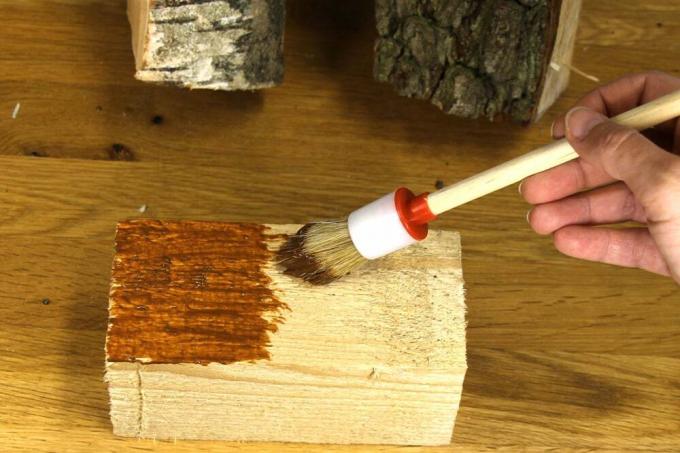

Table of contents
- What is wood care oil?
- The ingredients
- The binders
- The solvents
- additives
- The drying
- The protective film – hard wax oil
- pigments
- The right oil – selection
- The processing
- Common mistakes
Whether garden or house, wood is a popular building material. If it is used outdoors, however, it requires a certain amount of protection from wind, weather and sun. If there is no other coating, wood care oil is a good alternative. Below you can find out what types there are and how to use them.
What is wood care oil?
In order to understand the different types of oil and their application, it is first important to know the general properties of wood care oils:
- Not layering on the surface
- As a result, no additional protection against mechanical abrasion, wear and tear, etc.
- Penetrates the pores of the wood and leads to saturation of the upper layer of wood
- Preserves breathability and permeability
- Do not affect haptics and surface quality
- Depending on the type of oil, optical changes, such as darkening and color tone, are possible
The ingredients
Generally speaking, wood care oil consists of up to four ingredients:
- binder
- solvent
- additives
- pigments
The area of additives and pigments in particular is very variable and can also be omitted completely. The focus, on the other hand, is primarily on the binding agent, i.e. the substance that remains in the wood pores after it has dried completely and causes the protective effect.
The binders
Two different groups of substances have established themselves as common binders:
- Vegetable oils in their natural form, e.g. B. Linseed oil, soybean oil, sunflower oil or tall oil
- Modified oil, so-called alkyd resin, usually based on linseed oil or oil mixtures
Both oil groups are comparable in terms of their protective effect, so that from a technical point of view there is no difference noteworthy difference from the pure selection of the "crude oil" on which the wood care oil is based results. In most cases, a special orientation of a product is only achieved in the totality of all ingredients, i.e. the oil combinations and the additives.
The solvents
Next we look at the common types of solvents. Generally speaking, they are required in the wood care oil in order to make the usually viscous oils used as binding agents workable at all. They can be described as completely uncritical for outdoor use, since evaporated solvents can evaporate without any problems and do not lead to any enrichment of the ambient air.

Linseed oil varnish is usually used in combination with natural oils. Despite its use as a solvent, it is not one of the volatile substances, but dries in a comparatively long time. Modified oils, on the other hand, are usually combined with isoparaffins or petrol. These real solvents evaporate relatively quickly after processing and thus enable the oiled surface to be used quickly. In very rare cases, however, water can also be found as a solvent, although these products are hardly noticeable in the mass of products available on the market.
The solvent fractions
- Solvent-free oils: close to 0%, but never completely missing, since it is also necessary for drying additives
- Other care oils: up to shares of 40 to 60%
- Comparison: Varnishes up to 80% !!
DANGER:
Aliphatic / aromatic hydrocarbons are often found as solvents, especially in products of unclear origin. However, they are known to be hazardous to health and should therefore be avoided.
additives
If additives are added to the wood oil, these are substances that change a wide variety of aspects:
- drying accelerator
- Additives for a matt or glossy look
- Additives to create the protective film on the surface that oil does not have
The drying
Wood care oil is usually dried by oxidation. This means that the molecules of the oil react with the oxygen in the air and create long-chain compounds - they harden. Oil products are therefore often referred to as hard oil, although there is ultimately no difference between care oils with the name and oils without this suffix. Drying accelerators are usually added to modified oils in particular, although natural oils are also increasingly using them in order to survive on the market. The resulting drying times are usually in the following ranges:
- With accelerating additives: approx. 24 to 48 hours
- Without accelerator: 1 to 3 weeks
The protective film – hard wax oil
The most common and most recognizable additive to wood care oils for the end user is wax. Many of these products are available as hardwax oil, as well as under similar names. The added wax is intended to replace the protective film on the wood surface that is not actually present with oil. While the care oil penetrates deep into the pores of the wood, the wax forms a slightly shiny layer on the wood Wood and replaces, at least in moderation, the protective effect that is normally produced by varnishes or glazes becomes. However, the layer formation of the wax never reaches that of paint or glaze and must be renewed regularly due to the significantly lower durability.
Tip:
If you want to give your wood a waxed look, you will find a good variant in hardwax oil, which allows processing in a cold state. In its pure form, on the other hand, wax can usually only be processed when it is heated.
pigments
Many care oils are provided with product names such as "teak oil", "Bangkirai oil" or similar. Even if one might initially assume that the oil formulations were specially created for these types of wood it is ultimately only about the pigmentation, which can be found on the wood species that give it its name oriented. Unpigmented oil is usually colorless or only slightly colored. For example, linseed oil creates a slight yellow tinge. The oils are only able to emphasize the natural wood tone of a type of wood or to give other types of wood the appearance of a desired wood only when coloring agents are added. It is not unusual, for example, in the area of terraces or garden furniture to use cheaper woods, which are then "upgraded" by using teak oil.
The right oil – selection

With this knowledge of the differences between the individual wood care oils, it is easy to select the right oil for your own needs from the hardly manageable range in the specialist market. The following questions should be kept in mind:
- Time requirement: Is there a waiting time or oil with drying accelerators?
- Surface: film-forming hard wax oil, or pure care oil?
- Optics: only care effect desired, or emphasis or Color change caused by pigmented oils?
- gut feeling: Natural oil or "synthetic" alkyd resin?
The processing
Once you have decided on a wood care oil, it is time to process it. It is the same for all types of oil, so that the application can be described universally here:
- Application of an oil film to the wood with a brush or cloth
- Wait for the exposure time according to the manufacturer's instructions
- Rub any remaining oil on the surface with a rag and wipe off excess
DANGER:
Anyone who uses pure or almost pure linseed oil for wood care should soak the rag used after completing the work and seal it airtight in a plastic bag. The massive vapors from the linseed oil residues in the cloth can ignite under favorable conditions (strong solar radiation, etc.) when they come into contact with atmospheric oxygen! On the other hand, there is no danger whatsoever for the oil applied to the wood surface.
Common mistakes
Although the processing of wood care oils is very easy in itself, elementary mistakes are made again and again, which primarily affect the subsequent appearance of the surface:
- too little oil on the wood, resulting in stains from dried out areas with less oil
- Oil not rubbed and wiped off, resulting in stained surface due to remaining oil droplets
- Oiled surface walked on too early: Stains and streaks from dirt that has been brought in, as well as impairments to garden paths, etc. possible due to care oil on the shoes (especially absorbent types of stone)
 Home editorial office
Home editorial office
Learn more about furniture care

Poly rattan is becoming brittle: what to do?
Polyrattan is one of the most popular outdoor materials due to its weather resistance. Garden chairs and lounge furniture made of rattan are particularly popular. Over time it can happen that the material becomes brittle due to weather influences. In order to be able to use them for a long time, we explain how to repair them.

Caring for rattan furniture: cleaning, refreshing and painting
Looking after and cleaning rattan furniture initially seems difficult due to the structure and material. However, just like painting, it is quite easy with the right tools.

Teak furniture care with a high-pressure cleaner recommended?
Those who call modern teak furniture their own can indeed consider themselves lucky. In the recent past, teak has developed into a highly sought-after material for the production of indoor and outdoor furniture.

California Poppy, Eschscholzia californica: Care Instructions
Hardly any garden plant is as easy to care for as Californian poppy (Eschscholzia californica), which, with its golden yellow flowers, is a feast for the eyes in the home garden. In order to ensure the bright sea of flowers, a few points should be considered with regard to care.

Plant goji berries yourself - cultivation done yourself
If you want to grow and plant goji berries in your own garden, the attractive and easy-care wolfberry will not make it that difficult. Since the nightshade plant was probably originally native to warm Asia and south-eastern Europe, it needs a lot of sun, but can still survive the local winter well because it adapts to our climate got used to.

Home remedies for mosquito bites 5 tips to relieve itching
Swelling and redness caused by mosquito bites can be alleviated with numerous home remedies. The refrigerator, medicine cabinet or the herb garden offer various options that promote the healing process. Many agents have cooling properties, while other substances achieve antibacterial effects.



